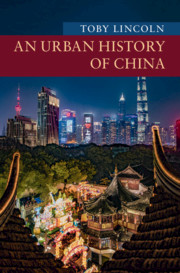Book contents
- An Urban History of China
- New Approaches to Asian History
- An Urban History of China
- Copyright page
- Contents
- Figures
- Maps
- Tables
- Acknowledgements
- Introduction
- 1 The Emergence of China’s Imperial Urban Civilization (Antiquity to 220 CE)
- 2 The Expansion of China’s Imperial Urban Civilization to the South (220–755)
- 3 The Tang-Song Transition and Its Effects on China’s Imperial Urban Civilization (907–1402)
- 4 The Flowering of Chinese Imperial Urban Civilization (1402–1799)
- 5 The Seeds of Urban Modernity (1800–1895)
- 6 Urban Modernity in Republican China (1895–1949)
- 7 The Maoist Period (1949–1976)
- 8 The Reform Era and the Present
- Conclusion
- Index
- Series page
- References
3 - The Tang-Song Transition and Its Effects on China’s Imperial Urban Civilization (907–1402)
Published online by Cambridge University Press: 29 April 2021
- An Urban History of China
- New Approaches to Asian History
- An Urban History of China
- Copyright page
- Contents
- Figures
- Maps
- Tables
- Acknowledgements
- Introduction
- 1 The Emergence of China’s Imperial Urban Civilization (Antiquity to 220 CE)
- 2 The Expansion of China’s Imperial Urban Civilization to the South (220–755)
- 3 The Tang-Song Transition and Its Effects on China’s Imperial Urban Civilization (907–1402)
- 4 The Flowering of Chinese Imperial Urban Civilization (1402–1799)
- 5 The Seeds of Urban Modernity (1800–1895)
- 6 Urban Modernity in Republican China (1895–1949)
- 7 The Maoist Period (1949–1976)
- 8 The Reform Era and the Present
- Conclusion
- Index
- Series page
- References
Summary
During the Tang-Song transition, urbanization created regionally distinct hierarchical networks of large and small cities, market towns, and villages, which were closely connected in complex economic, social, and political relationships. The Lower Yangzi Delta was the most urbanized region of China, and remained linked to northern capitals via the Grand Canal. Within Chinese capitals, emperors, aristocrats, and officials remained enclosed within palace and imperial cities. Outside, the ward system broke down, and in many smaller cities there were no walls at all. Now commerce could be found along every street, and it also brought new forms of social organization and governance. Merchants organized different trades into guilds and took their place alongside the state and religious institutions in governing urban life. In capital cities, imperial families continued to assert their symbolic right to rule through participation in now well-established rituals. Elsewhere, people from all social classes were more invested in the urban life of their city, and distinct urban cultures emerged. Local gentry wrote urban histories and guides, bought and sold property, and invested in businesses or religious institutions. They describe lives of urban men and women in levels of detail that do not exist for earlier eras.
- Type
- Chapter
- Information
- An Urban History of China , pp. 76 - 104Publisher: Cambridge University PressPrint publication year: 2021

